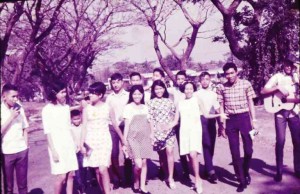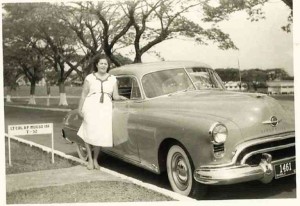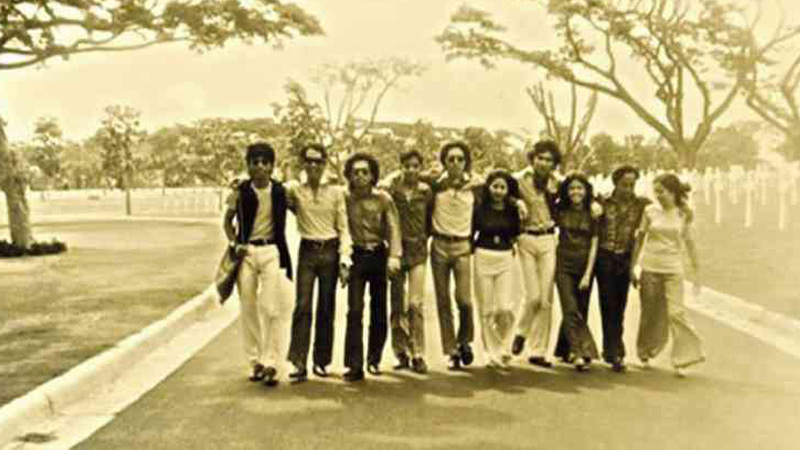

A drug lord was going to be executed that dawn.
In the stillness of that morning, we heard the volley of shots. They sounded like they were coming from my headboard. I learned later in the day that a man was sentenced to death by firing squad, and it happened in the target shooting range, a 15-minute walk from our house. No wonder.
The sounds were not new.
Shots always rang out in our backyard, friendly shots though. That was where on weekends Father would take us and teach us all the stances for rifle shooting, from prone position to standing.
We were never allowed to go there on our own, although some of the naughtier boys would sneak some horses from the cavalry stables and ride them out there in the firing range, galloping all the way to Taguig.
I developed a textured sense of place in Fort Bonifacio, long before it became an act of real estate called Republic Act No. 7227, where Wagyu burgers and fancy cupcakes now rule.
Fort William McKinley
Established in 1901 during the Philippine-American War in an area just southeast of the center of Manila, Fort Bonifacio is now being disputed by the cities of Makati and Taguig, as well as the municipality of Pateros.
This land south of the Pasig River down to Alabang was declared a US military reservation by then Secretary of War Elihu Root, and was then called Fort William McKinley.
In 1916, the 3rd Battalion of the 31st Infantry Regiment was formed here, and they made it their home until 1920.
During World War II, the USAFFE headquarters for the Philippine department and the Philippine division were also stationed and received artillery training here.
When the Japanese occupied the Philippines in 1942, the fort was taken over and occupied by the Japanese Imperial Army until the end of the war in 1945.
After the declaration of Philippine independence in July 1946, the US surrendered all rights of possession, jurisdiction, supervision and control over the Philippine territory, except the use of its military bases then. Finally, on May 14, 1949, Fort William McKinley was turned over to the Philippine government and renamed Fort Andres Bonifacio.

It became the home of the Philippine Army first, and later the Philippine Navy. The Manila American Cemetery and Memorial was also established here, all of 152 acres on a sprawling plateau. The war memorial remains under American jurisdiction to this day.
In 1992, the Bases Conversion Development Authority (BCDA), a government-owned corporation mandated to transform former US military bases into alternative productive civilian use, was created through Republic Act No. 7227.
Major urban development
In 1995, Bonifacio Land Development Corp., a consortium led by Metro Pacific, made a successful bid to become BCDA’s partner in the property and started planning a major urban development they would call Bonifacio Global City (BGC).
When the wrecking crews came in, a friend recalls crying at the sight of the bulldozers and payloaders demolishing old landmarks.
In the ’60s, we moved to Manila after my father’s posting in the III Military Area, Lahug, Cebu City. I was young and very impressionable.
We were assigned a three-bedroom house referred to as quarters. In fact, all of the houses were called Qs. Our address was Q-131 on McArthur Road, which ran parallel to McArthur Avenue, the main drag that winded all the way to the outskirts of Pateros.
The landscape remains unchanged in my mind to this day: wide, paved, with ancient acacias lining main roads that had sidewalks to bike or walk on as far as our legs could take us.
Under clear skies, in open spaces, and on grassy lawns without fences, we learned how to play softball with wooden bats and get out of the way when we heard golfers shout “Fore.”
Some neighbors had six-seater swings on their front yards where we spent afternoons dreaming big and small and sharing the latest camp tattle. Father built a tree house in our backyard for my younger brothers and their friends; naturally, they called themselves the Treetops Gang.
This was a childhood where you could wait for your neighbor’s mom to take a pan of freshly baked cookies from the oven and swipe some while she wasn’t looking.
Summers were wonderful with other branches of service, athletic teams coming over to play interleague basketball at the Army gym.
On Saturdays, we’d all go swimming in the pool of the old Officers Club, which overlooked Laguna de Bay. On some afternoons, we’d race our bicycles down a steep paved road near the army hospital in the general area where now stands the British School of Manila.
I always wore a favorite pair of white culottes for duckpin bowling days at a four-lane alley in an area called Concessionaires. My older sisters joined the church choir, formed a group singing songs by Joan Baez, Peter, Paul and Mary, and the Everly Brothers, went to “barn dances” and jam sessions, and slept with humongous rollers in their hair.
I’d wake up to the strains of Sousa marches playing on the phonograph, then play my Beach Boys records as soon as Father stepped out to work, but would quickly get overruled and end up listening to my sisters’ Johnny Mathis.

There was a white lady who haunted us all on moonless nights.
When vacations were over, we would go to school riding in 6×6 trucks that were called weapons carriers, assigned different routes depending on locations of our respective schools. We made more friends from other parts of the fort.
Rolling terrain
After all, it was all of 25.78 square kilometers, spread out on rolling terrain. There was the golf course with its long fairways that cut through roads around our houses, the Marine barracks, cavalry and stables, the army hospital, the church, Jusmag housing, consular housing, the parade grounds, the American Memorial Cemetery, Libingan ng mga Bayani, the forested and hilly area behind our houses, now a 50-hectare township called McKinley Hill with residential pockets called Venice, Tuscany, Venezia; and the not-so-guarded-secret tunnels with their apocryphal tales of a Japanese Imperial Army gold cache and rusty samurai swords.
Walking distance from our backyard was also an outcrop of boulders; you had to climb to get to its top. It was a good spot to nourish the soul.
Gerry Misa reminisces and records his gratitude: “From the big rock behind our house, I could see the target shooting range, the Pateros Bridge and the dome of the Pateros church; farther away, the Laguna Bay shoreline. On Sundays, riding on the wind from Laguna and the small towns surrounding it, I would hear the frantic shouts of bettors from cockpits.
“I spent many hours on that rock, dreaming, singing Neil Sedaka songs, practicing for elocution contests. Years after, when I joined the military, I came back in my Navy helicopter and hovered over it, in one last farewell and salute to the measureless joys it gave me.”
The rock has been partly dislodged by a giant mall, but I can still see parts of it, if I look up driving south on my right side, as I pass by C-5.
I didn’t give thought to the ozone layer then, maybe because it was fairly intact: climatic and weather patterns were almanac-predictable. Hundreds of giant acacia trees were home to many species of birds, like orioles, kingfishers and martines. There was no greenhouse effect causing summers with oppressive heat, no landslides, no flashfloods, a few strong typhoons.
Fruits appeared in tune with the seasons, and the healing rains of May fell right on schedule. Our homes and cars were cooled by electric fans and open windows. At daybreak, we’d hear the jogging cadences of Marines and, at dusk, taps was sounded.
The simple pleasures were many and memorable, not one of us can ever name only one.
It was a happy childhood enriched by friendly and helpful neighbors, small town events, seasonal and religious rituals, and tropical pastoral backyard vistas. It was a real community.
A man went to the moon, and we all owned Gloria Diaz the day she was crowned Miss Universe. A young, charismatic president from far away America was assassinated and all of a sudden a town called Dallas was in our collective consciousness.
It was also a time my sense of civic pride was formed. We were all proud of doing our share to make the fort a clean, safe and happy place to live in. Civilian authority ruled. The military served and became more involved in nonmilitary tasks, particularly in engineering and road-building projects.
From 1964 to 1971, the Philippine Civic Action Group (PhilCag) and the Philippine Contingents (Philcon) were sent to serve the medical, dental, engineering and other needs of the Vietnamese citizenry during the Vietnam War.
But, not so far away, an urgent world awaited.
Retirement age
When Martial Law was declared, Father had reached mandatory retirement age. So, we once again packed our bags, and this time moved to our own house outside the fort.
It was a good time to leave my most favorite place on earth. It was mine, but it was also time to move out. We had to make way for another officer and his family to be able to move in. Father always said, privileges, like all good things, come to an end.
A new home, new friends, the passing demands of time and the vicissitudes of life happened.
After a few years, it seemed to me like the military had changed. It had become the implementer of a new regime’s policies. Its role had expanded to include participation in the political process involving judicial, administrative and industrial management functions.
Winds of change
The winds of change had blown hard over the fort of our childhood. Friends had also started moving out, officers’ housing started looking different with walls and fences separating one house from another. Garages to accommodate more cars were being built.
Color-coded alerts made entering the old gates more difficult each time I went to visit with a few old friends who were still living there. The younger soldiers all seemed restless for change and bigger things to happen. The area where we swam all summer was repurposed and became something called Internal Security Group Compound, a softer name for Detention Center (for political prisoners) and was off-limits to unauthorized persons.
Change really happened.
I took it as a sign that the AFP had now become a decisive political force. I never saw those childhood friends again until that urgent world that loomed over us then became today. The reconnections have begun.
Flower children
Slowly, many of them have started entering my life now as retired generals, aging ideologues, commercial and military pilots, ambassadors, gentlemen farmers, lawyers, former rebels, politicians, proud grandparents, a preacher, a yoga master: gentle flower children all.
For many people, Fort Bonifacio now evokes luxury condominiums with floor-to-ceiling windows and soaring views, townhouses with five-star high-end lifestyle retail stores, BPOs and corporate head offices, restaurants, schools, and malls.
Even if I look hard enough, I can no longer make out my bike route from our house to the commissary where High Street of the new BGC is today. I can’t find my private pleasures under all the new glitz. The only points of reference left are the American Cemetery and Memorial, the grassy rotunda in front of it, the Libingan ng mga Bayani, the HPA (Headquarters Philippine Army) and parade grounds and trusty old Runway 24 (still in use today for planes to align their long final positions before proceeding to the main runway beside SLEx).
Winding road
I find my bearings today by going down the old McKinley Road of a once patrician and genteel Forbes Park. Where my sisters clandestinely learned how to drive, I now have to take the winding road with care, dodging speeding cars, buses and colorum motorbikes called habal-habal shuttling commuters to the global city.
Still, it is a good time to gather for a reunion in February in the last remaining sector of the fort that’s still under AFP jurisdiction: the newer Officers Club near the parade grounds.
It is organized by the Army Brats, a group that evolved from an earlier batch of Fort Bonifacio residents who called themselves Friends Inc., then spearheaded by Bobby Friedlander.
I hear many will be coming home from abroad. Will they be able to find the venue on Google? Or will they have secret landmarks from a time in their lives when everything was possible as reference points?
No worries. It will be a sweet and happy event. A map remains in our hearts; they will find their way.
For details, contact Albert Mendoza at 0917-2429162.













































